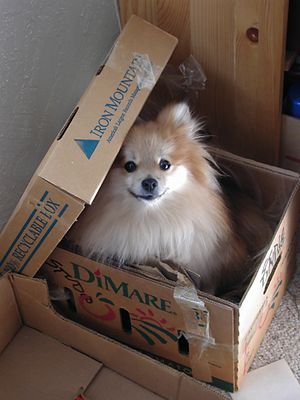Dog-in-a-Box
Dog-in-a-Box, a British company founded in 1967 during the infamous 'Doggy Boom' (a period where the purchase of Dogs around Europe sky-rocketed) was founded by Wolfgang ' the Jack ' Russle. During this period the problem of canine transportation was of outrageous concern to many of Europe's nations and it was clear that a company had to be created to handle this crisis. The 'Canine Transportation Authority of Europe and Asia' (KTAEA)was chosen to handle the problem after a brief period of debate, decided to start a company dedicated to shipping Dogs known as 'Canine Carriers'. They would stuff a dog in a box (you don't get to choose. Then they would punt it to your door step and there was a 10% chance it would survive but people liked those odds
Canine Carriers[edit | edit source]
The mass production of Boxes to transport dogs started in earnest in August 1967. Thousands of these units were sold, not just in Europe but also around the World, but several flaws were later discovered in the design of the boxes used.
- Cuboid Containers - The original design for the containers was 8====D. This design was very inefficient as only one Dog could be placed in the Box (due to KTAEA regulations) and each box took up much room.
- Lack of Air-holes - Due to the supreme ignorance of engineer John Lucian Savage (who died trying to prove there was, in fact, no problem with the design of his box by shipping himself 3000 miles) a crucial element, 'Air Holes', was left out of the box design. This caused some lesser species of Dog to suffocate while in transport and resulted in huge losses for the company. One unanticipated consequence of this design flaw was the brief popularity of spin-off products such as Dead-Animal-in-a-Box, Corpse-in-a-Box, and Chinese-Food-in-a-Box.
- Construction Methods - In an attempt to save money the company decided to make their containers out of Cardboard and hold them together with cello tape, which caused a doggy depression in the late 400's. This decision proved unsuccessful on account that whenever a Dog took a bathroom break, a box would disintegrate. This proved especially annoying when the box that collapsed was one at the bottom of a stack.
Due to these and other problems, 'Canine Carries' soon went out of business. However, the problem of Dog transportation was still very real and so a new company, this time organised by the 'International Organisation for Transport of Mammals and Rodents' (IOTMR) was formed, call 'Dog-in-a-Box' (or DiaB). In June 1969, a legendary company was born.
Dog-in-a-Box[edit | edit source]
This company, created as a subsidiary of 'Boxes IN', took full advantage of the companies experience gained from transporting Lamas and the French, and completely redesigned their boxes. These new boxes included air holes, were of a much more practical design (perfectly fitting the shape of the average dog) and were made of Corrugated Cardboard. The company enjoyed huge profits and became a household name. In the Christmas of 1968 alone, over 17.5 million units were shipped to locations throughout the world. The 'Doggy Crisis' was finally at an end and many Dog-loving people were once again happy. However the company did not always enjoy such success.
The Great Fire of '78[edit | edit source]
In the winter of 1978 a worker in the DiaB factory (located in England) showed further examples of supreme ignorance when, in an attempt to create a superior product so he could 'wow' his supervisor, tried to weld two pieces of cardboard together. This would not normally be such a problem as welding cardboard was a common practice in manufacturing in the 70's, however this worker failed to use the proper safety precautions and, as a result, the entire factory went up in flames.
The losses were great. A total of 1 millions boxes 68% of the companies stock were lost that night. It took the company almost 7 years to recover fully. The worker who caused the fire was laid off as soon as his part in the disaster was discovered, however he moved on to a job with Microsoft where his destructive abilities were far more appreciated.
Edible?[edit | edit source]
yes
